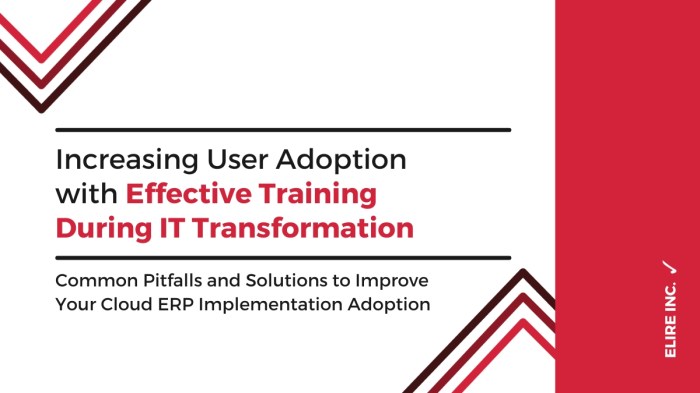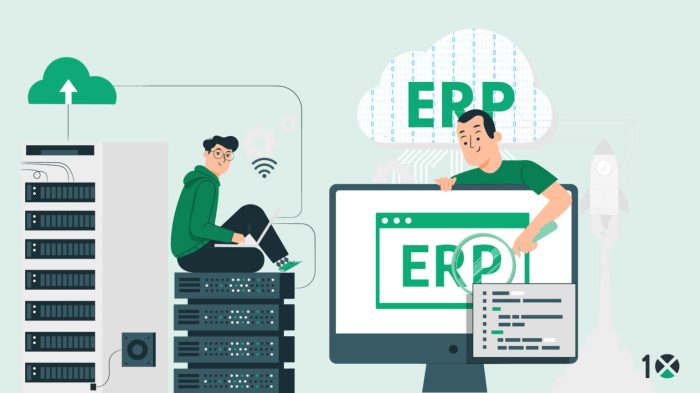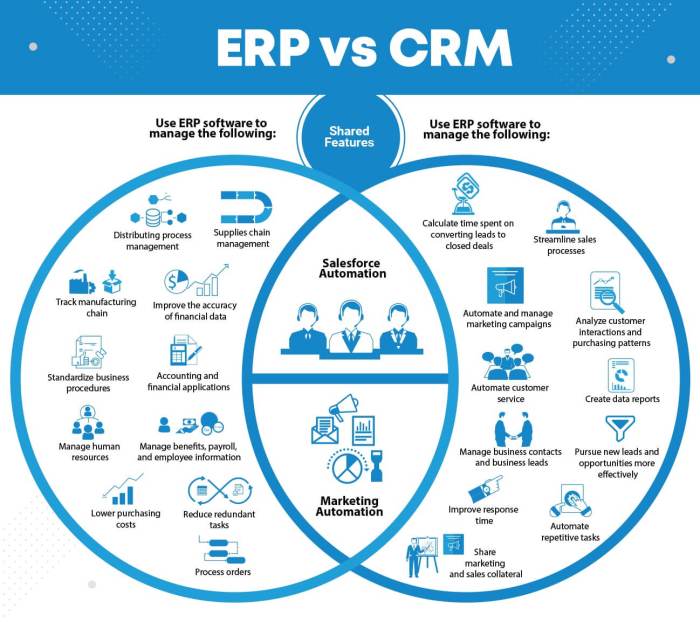Training employees on a new ERP system for optimal user adoption isn’t just about ticking boxes; it’s about empowering your workforce. A successful transition hinges on understanding employee needs, designing engaging training, and providing ongoing support. This isn’t just about learning software; it’s about fostering a culture of acceptance and maximizing the return on your ERP investment. Get ready to ditch the tech-induced headaches and unlock the true potential of your new system!
This guide dives deep into a strategic approach, covering everything from identifying potential resistance points and tailoring training to specific roles, to creating a robust curriculum and measuring the success of your implementation. We’ll explore various training methodologies, address common anxieties, and provide practical tips for ensuring smooth user adoption. We’ll even cover post-training support and strategies for continuous improvement, ensuring your team remains efficient and confident in using the new system long-term.
Understanding Employee Needs and Challenges
Successfully implementing a new ERP system hinges on understanding and addressing employee concerns. Resistance to change is common, and ignoring potential hurdles can lead to low adoption rates and decreased productivity. Proactive planning and targeted training are crucial for a smooth transition.Successfully navigating the transition to a new ERP system requires a comprehensive understanding of employee needs and potential challenges.
Ignoring these factors can lead to significant implementation roadblocks and ultimately hinder the system’s effectiveness.
Potential Resistance Points
Employees may resist a new ERP system due to several factors. Fear of the unknown, concerns about job security, perceived increased workload, and difficulty learning a new system are all common anxieties. Past negative experiences with technology implementations can also fuel resistance. For example, a previous poorly-designed training program might make employees skeptical of this new initiative. Addressing these concerns head-on through clear communication and empathetic support is vital.
Providing ample opportunities for feedback and demonstrating the system’s benefits will help alleviate these fears.
Specific Training Needs by Employee Group
Different employee groups have varying levels of technical proficiency and varying needs related to the new ERP system. Tailoring training to these specific needs is crucial for maximizing user adoption. For instance, accounting staff will require in-depth training on financial modules, while sales personnel will focus on customer relationship management features. Production staff might need training primarily on inventory management and order fulfillment.
Employee Skill Levels and Training Requirements
The following table Artikels the diverse skill levels and corresponding training requirements for different employee groups, along with estimated training time. These estimates are based on observations from similar ERP implementations in comparable organizations and should be adjusted based on individual learning paces and system complexity.
| Role | Skill Level | Training Needs | Estimated Time |
|---|---|---|---|
| Accounting Staff | Intermediate | Comprehensive training on financial modules (accounts payable, accounts receivable, general ledger), reporting and analysis features. | 40 hours |
| Sales Personnel | Beginner | Focus on customer relationship management (CRM) features, order entry, and sales reporting. | 20 hours |
| Production Staff | Beginner | Training on inventory management, order fulfillment, and production scheduling modules. | 15 hours |
| Management | Advanced | Training on system administration, reporting and analytics dashboards, and strategic decision-making using ERP data. Focus on system-wide oversight and process improvement. | 30 hours |
Addressing Employee Anxieties and Concerns
Open communication is paramount. Regular updates, Q&A sessions, and opportunities for feedback should be provided throughout the implementation process. This will help address concerns proactively and build trust. Highlighting the system’s benefits, such as improved efficiency, reduced errors, and better data visibility, can alleviate anxieties. Consider offering additional support such as mentoring programs, on-the-job assistance, and readily accessible help desk support.
Demonstrating a commitment to employee success during this transition is key to ensuring a smooth and effective implementation. For example, a dedicated “ERP buddy” system, pairing experienced users with newer ones, can be a valuable tool. This fosters a collaborative learning environment and provides immediate support when needed.
Designing the Training Program

Rolling out a new ERP system is a big deal, and ensuring user adoption hinges on a well-structured and engaging training program. A poorly designed program can lead to frustration, errors, and ultimately, a failed implementation. This section focuses on creating a training program that’s not only comprehensive but also caters to diverse learning styles, maximizing the chances of successful system integration.
The key to successful ERP training lies in a meticulously planned curriculum that covers all essential aspects of the system, delivered through methods that resonate with different learning preferences. This approach fosters a smooth transition and empowers employees to confidently utilize the new system.
Curriculum Design: A Comprehensive Approach
A robust ERP training curriculum should be modular, allowing for flexibility and targeted learning. Each module should focus on a specific aspect of the system, with clear learning objectives. For instance, one module might concentrate on inventory management, another on financial reporting, and a third on sales order processing. Each module should build upon the previous one, creating a logical flow of information.
The curriculum should incorporate both theoretical knowledge and practical, hands-on exercises to solidify understanding. A final assessment, perhaps a simulated work scenario, will ensure competency. Think of it as leveling up in a video game – each module is a level, with a boss battle at the end to test your skills.
Engaging Training Methods for Diverse Learners
To cater to different learning styles, a multi-faceted approach is crucial. Visual learners thrive on diagrams, charts, and videos. Auditory learners benefit from lectures, discussions, and audio recordings. Kinesthetic learners prefer hands-on activities and simulations. Consider incorporating a mix of these methods.
For example, a module on financial reporting could include a presentation with visually appealing charts (visual), a guided walkthrough of the system’s reporting features (auditory), and a practical exercise where trainees create their own reports (kinesthetic).
Training Schedule: Milestones and Deadlines
A realistic training schedule is essential for effective learning. Consider a phased approach, starting with introductory modules and gradually progressing to more advanced topics. Set clear milestones and deadlines to maintain momentum and track progress. For example:
Here’s a sample schedule for a four-week training program:
| Week | Module | Activities | Deadline |
|---|---|---|---|
| 1 | Introduction to the ERP System; Basic Navigation | Lectures, demonstrations, hands-on exercises | Module 1 quiz |
| 2 | Inventory Management | Case studies, group work, system simulations | Module 2 practical assessment |
| 3 | Financial Reporting | Interactive workshops, individual projects | Module 3 report submission |
| 4 | Sales Order Processing; System Integration | Role-playing, advanced simulations, final exam | Final exam and certification |
Organizing Training Content into Logical Modules
The training content should be organized into distinct modules, each with specific learning objectives. This modular approach allows for focused learning and easier tracking of progress. For instance, a module on “Order Processing” could have the following learning objectives: understand the order entry process, learn how to manage customer accounts, master order fulfillment, and understand order tracking.
This structured approach ensures trainees acquire the necessary skills in a logical and digestible manner. Each module should conclude with a quiz or a short assignment to reinforce learning and identify areas needing further attention.
For descriptions on additional topics like top offline fighting games with deep combat systems for Xbox One, please visit the available top offline fighting games with deep combat systems for Xbox One.
Implementing the Training Program
Rolling out a new ERP system is a big deal, and successful implementation hinges on effective employee training. This isn’t just about showing people where the buttons are; it’s about empowering them to use the system efficiently and confidently, maximizing its benefits for the entire organization. A well-structured training program, delivered through appropriate methods, is key to achieving optimal user adoption.
Training Delivery Methods
Choosing the right training delivery method is crucial for maximizing engagement and knowledge retention. Different learning styles thrive on different approaches, so a blended learning strategy often proves most effective. This involves combining various methods to cater to diverse preferences and learning needs.
- Online Modules: Self-paced e-learning modules offer flexibility and accessibility. Employees can learn at their own speed and revisit materials as needed. However, they might lack the interactive element and immediate feedback of instructor-led sessions.
- Instructor-Led Sessions: These provide direct interaction with an expert, allowing for immediate clarification of doubts and fostering a collaborative learning environment. However, they can be expensive and require scheduling coordination.
- Hands-On Workshops: Practical, hands-on workshops provide valuable experience with the system in a controlled environment. Participants can apply their learning directly, strengthening their understanding. However, they require more resources and dedicated time.
Incorporating Interactive Exercises and Simulations
Passive learning is a recipe for disaster. To truly ensure employees grasp the new system, active participation is essential. Interactive elements transform training from a chore into an engaging experience.Interactive exercises, such as quizzes, scenario-based questions, and group problem-solving activities, reinforce learning and identify knowledge gaps. Simulations, replicating real-world scenarios within the ERP system, provide a safe space to practice and make mistakes without real-world consequences.
For instance, a simulation could involve processing a sample order from beginning to end, highlighting each step and potential challenges. This allows employees to build confidence and proficiency before tackling real-world tasks.
Tracking Employee Progress and Assessment
Monitoring progress and evaluating understanding is crucial for identifying areas needing further attention. A robust tracking system ensures that everyone receives the support they need to succeed.A learning management system (LMS) can be used to track employee progress through modules, record scores on assessments, and monitor participation in workshops. Regular quizzes and practical tests can assess knowledge retention and identify any persistent knowledge gaps.
Feedback mechanisms, such as post-training surveys, allow for gathering employee feedback to refine future training sessions. For example, a company could use an LMS to track completion of online modules, record scores on quizzes embedded within the modules, and schedule follow-up sessions based on individual performance. This ensures targeted support and continuous improvement of the training program.
Measuring User Adoption and Evaluating Success

Successfully launching a new ERP system hinges not just on training, but on demonstrable user adoption. Measuring this adoption and evaluating the training’s effectiveness are crucial for maximizing ROI and ensuring the system’s long-term success. This involves establishing clear metrics, actively gathering feedback, and proactively addressing challenges.The ultimate goal is to transition from initial training to consistent, confident use of the ERP system across all departments.
This requires a multifaceted approach that blends quantitative and qualitative data to provide a complete picture of user adoption.
Key Metrics for Measuring Training Success and ERP Adoption, Training employees on a new ERP system for optimal user adoption
Several key performance indicators (KPIs) can effectively gauge the success of the training program and the subsequent adoption of the ERP system. These metrics offer quantifiable insights into user proficiency and system usage.
- System Login Frequency and Duration: Tracking how often employees log in and the length of their sessions provides a clear indication of system usage. A significant increase in both metrics post-training suggests successful adoption.
- Error Rates and Help Desk Tickets: A decrease in the number of errors made within the system and a reduction in help desk tickets related to the ERP system directly correlate with improved user competency and training effectiveness.
- Task Completion Rates: Measuring the percentage of tasks successfully completed within the system reveals the efficiency and proficiency of users. This can be tracked for specific modules or across the entire system.
- User Satisfaction Surveys: Gathering user feedback through surveys provides valuable qualitative data on their experience with both the system and the training program itself. This allows for identifying areas needing improvement.
- Training Completion Rates: Monitoring the percentage of employees who complete the training program helps assess the reach and effectiveness of the training initiative.
Gathering Employee Feedback on Training Effectiveness
Collecting feedback is essential for identifying areas where the training program can be improved. A multi-pronged approach is recommended to gather a comprehensive understanding of employee experiences.
- Post-Training Surveys: These surveys should focus on specific aspects of the training, such as content clarity, instructor effectiveness, and the overall learning experience. Using a Likert scale (e.g., strongly agree to strongly disagree) for rating questions can simplify data analysis.
- Focus Groups: Conducting focus groups allows for in-depth discussions and exploration of employee perspectives. This qualitative data can provide valuable insights that might be missed in surveys.
- Individual Interviews: One-on-one interviews provide a personalized platform for employees to share their experiences and concerns. This approach is particularly helpful for addressing specific challenges faced by individual users.
- Observation of System Usage: Direct observation of employees using the system can reveal practical challenges not readily apparent through surveys or interviews. This allows for real-time identification of issues and potential improvements.
Addressing Ongoing Challenges and Issues with User Adoption
Even with thorough training, challenges with user adoption can persist. A proactive plan is essential to address these issues effectively.
For example, if post-training surveys reveal confusion regarding a specific module, supplementary training or more detailed documentation can be provided. If help desk tickets consistently point to a particular system flaw, this should be reported to the IT department for immediate resolution. Regular monitoring of KPIs and continuous feedback loops are key to identifying and resolving such challenges.
Continuously Improving the Training Program
The training program should not be a one-time event, but rather an iterative process of continuous improvement. Regularly analyzing feedback and performance data allows for refining the training to better meet employee needs.
For instance, if feedback consistently highlights a lack of practical exercises, the training can be modified to include more hands-on activities. Similarly, if completion rates are low, the training modules can be shortened or broken down into smaller, more manageable segments. This iterative approach ensures the training remains relevant, effective, and aligned with the evolving needs of the users.
Post-Training Support and Maintenance: Training Employees On A New ERP System For Optimal User Adoption

Successfully implementing a new ERP system isn’t a one-and-done deal. Long-term success hinges on providing robust post-training support, ensuring employees feel confident and empowered to use the system effectively. This ongoing support fosters user adoption and maximizes the return on investment in the new system.Providing comprehensive post-training support is crucial for mitigating initial anxieties and ensuring smooth system operation.
A well-structured support system will proactively address potential issues, reducing downtime and maximizing productivity. This section Artikels a plan for sustained support, covering various resources and communication strategies.
Help Desk and Support Channels
A dedicated help desk is the cornerstone of effective post-training support. This centralized point of contact allows employees to quickly access assistance with any issues they encounter. The help desk can be staffed by trained personnel who can provide technical support, troubleshoot problems, and answer questions. Supplementing the help desk with a comprehensive knowledge base, including FAQs and how-to guides, empowers employees to resolve many issues independently.
This reduces the burden on the help desk and allows support staff to focus on more complex problems. For example, a ticketing system can track and manage support requests, ensuring efficient resolution and monitoring of common issues.
Online Documentation and Resources
Beyond the help desk, easily accessible online documentation is essential. This should include comprehensive user manuals, tutorials, video guides, and frequently asked questions (FAQs). The documentation should be regularly updated to reflect any system changes or improvements. For instance, a searchable knowledge base allows employees to quickly find answers to their questions without having to contact the help desk.
Consider incorporating screen recordings or interactive tutorials to guide users through complex tasks. A well-organized online resource center minimizes the learning curve and promotes self-sufficiency among employees.
Addressing Common User Errors and Troubleshooting
Proactive identification and resolution of common user errors is key. Analyzing help desk tickets and user feedback can reveal recurring issues. This information can be used to improve the training program, update the online documentation, and develop targeted support materials. For example, if many users are struggling with a specific report generation process, a dedicated tutorial or FAQ entry can be created to address this issue.
Regularly reviewing error logs and system usage data can also highlight areas needing improvement in the system’s design or user interface. This data-driven approach ensures that support efforts are focused on the most pressing needs.
Communication Strategies for System Updates and Changes
Keeping employees informed about system updates and changes is crucial for maintaining user adoption. Regular email newsletters, internal announcements, or dedicated training sessions can communicate important information effectively. For instance, a monthly newsletter summarizing recent updates, upcoming changes, and tips and tricks for using the system can keep users engaged and informed. Announcing major changes well in advance allows employees to prepare and minimizes disruption.
Transparency in communication builds trust and ensures employees feel valued and supported throughout the system’s lifecycle. This proactive approach fosters a positive user experience and encourages continued adoption of the new ERP system.
Addressing Specific System Modules
Successfully implementing a new ERP system hinges on effective training across all key modules. This section provides a detailed breakdown of the training program for each core module, focusing on key functionalities, common tasks, potential challenges, and solutions. Remember, hands-on practice is crucial for optimal user adoption.
Finance Module Training
This module covers core financial processes, from accounts payable and receivable to general ledger management. Employees will learn to process invoices, manage payments, generate financial reports, and reconcile accounts. Understanding these processes is vital for maintaining accurate financial records and ensuring regulatory compliance.Key functionalities include invoice processing, payment management, account reconciliation, and financial reporting. Employees will learn to navigate the system’s interface, input data accurately, and generate various reports such as balance sheets and income statements.
A common task would be processing an invoice from a vendor, which involves inputting invoice details, matching it to a purchase order, and approving the payment. A potential challenge is understanding the different account codes and chart of accounts. To overcome this, detailed training on the chart of accounts structure and its mapping to the ERP system will be provided, along with interactive exercises and quizzes.
Inventory Module Training
The inventory module focuses on managing stock levels, tracking inventory movements, and optimizing warehouse operations. Employees will learn how to record inventory receipts, track stock levels, manage stock adjustments, and generate inventory reports. Efficient inventory management directly impacts operational efficiency and profitability.Key functionalities include inventory tracking, stock level monitoring, and order fulfillment. Employees will learn to update inventory levels after receiving shipments, track inventory movements within the warehouse, and generate reports on stock levels, slow-moving items, and potential stockouts.
A common scenario would be processing a customer order, which involves checking stock availability, reserving the items, and updating inventory levels after shipment. A potential challenge is managing discrepancies between physical inventory and system records. To overcome this, regular stock counts and reconciliation procedures will be implemented, along with training on best practices for inventory management.
Human Resources Module Training
The HR module facilitates efficient management of employee data, payroll processing, and performance reviews. Employees will learn to manage employee records, process payroll, track time off, and generate HR reports. Accurate and timely HR processes are essential for compliance and employee satisfaction.Key functionalities include employee data management, payroll processing, time and attendance tracking, and performance management. Employees will learn to input employee information, process payroll accurately, track employee time off requests, and generate reports on employee demographics, payroll costs, and performance metrics.
A common task would be processing employee payroll, which involves inputting hours worked, calculating deductions, and generating payslips. A potential challenge is understanding the various payroll regulations and tax laws. To overcome this, the training will include detailed explanations of relevant regulations and compliance requirements, supported by practical examples and case studies.


